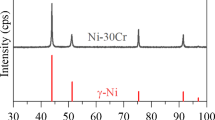Abstract
In most cases, chromia scales are assumed to grow by predominant chromium diffusion. However, results of Atkinson and Taylor indicated that chromium bulk diffusion could not account for the growth rate of chromia scales. Moreover, recent results of Parket al. showed that oxygen diffusion in chromia was faster than chromium diffusion. So, at this date, the controlling process of the growth of chromia scales is not elucidated.
To interpret such a phenomenon, oxygen and chromium self-diffusion coefficients in Cr2O3 single crystals and polycrystals were determined in the same materials and in the same experimental conditions, thus allowing a direct comparison. Tracers were introduced by ion implantation, thick film methods, and isotopic exchange, using the54Cr,50Cr and18O isotopes. Depth profiling was made by secondary ion mass spectroscopy (SIMS). The bulk diffusion coefficients were computed by using a general solution of the Fick's law taking into account evaporation and exchange at the surface. Grain-boundary diffusion coefficients were computed by using the Whipple-Le Claire equation for type B intergranular diffusion. Lattice and grain boundary self-diffusien coefficients were determined as a function of temperature and oxygen pressure.
The diffusion coefficients are lower than results given in the literature and do not depend on the oxygen pressure. Moreover, it is found that oxygen diffusion is faster than chromium diffusion. These results are compared to the oxidation constants of chromia-forming alloys and it is shown that neither lattice self-diffusion, nor grain-boundary self-diffusion can justify the growth rate of chromia scales. Such a situation is compared to NiO case, for which authors found important differences in grain-boundary diffusivity, according to the elaboration mode of NiO (thermal oxidation or growth from the melt).
Similar content being viewed by others
References
K. P. Lillerud andP. Kofstad,J. Electrochem. Soc. 127 (1980) 2397;Oxid. Met. 17 (1982) 127 and 195.
H. Hindam andD. P. Whittle,Oxid. Met. 18 (1983) 245.
A. Atkinson,Rev. Mod. Phys. 57 (1985) 437–470.
P. Kofstad, “High temperature corrosion” (Elsevier Applied Science, London, 1988).
A. C. S. Sabioni, B. Lesage, A. M. Huntz, J. C. Pivin andC. Monty,Phil. Mag. Part I, in press.
M. J. Bennet andD. P. Moon, “The role of active elements in the oxidation behaviour of high temperature metals and alloys”, edited by E. Lang (Elsevier Applied Science, CEC, Petten, 1989).
W. C. Hagel andA. V. Seybolt,J. Electrochem. Soc. 108 (1961) 1146.
L. C. Walters andR. E. Grace,J. Appl. Phys. 36 (1965) 2331.
K. Hoshino andN. L. Peterson,Bull. Amer. Ceram. Soc. (1983) C 202.
A. Atkinson andR. I. Taylor,NATO-ASI,B 129 (1984) 285.
J. H. Park, W. E. King andS. J. Rothman,J. Amer. Ceram. Soc. 70 (1987) 880.
W. E. King andJ. H. Park, in Conference Proceedings Materials Research Society, Spring Meeting, Reno, Nevada (1988).
C. Greskovich,Comm. Amer. Ceram. Soc. 67 (1984) C111-C112.
A. C. S. Sabioni, A. M. Huntz, F. Millot andC. Monty,Phil. Mag. Part II, in press.
A. Atkinson, M. L. O'dwyer andR. I. Taylor,J. Mater. Sci. 18 (1983) 2371.
A. C. S. Sabioni, A. M. Huntz, F. Millot andC. Monty,Phil. Mag. Part III, in press.
A. C. S. Sabioni, Doctor Thesis, University Paris XI, Orsay, France, (1990).
A. C. S. Sabioni, B. Lesage, A. M. Huntz, J. Besson, C. Dolin andC. Monty,Colloq. Phys. C51 (1990) 611–616.
W. C. Hagel,Trans. Amer. Soc. Metals 56 (1963) 583.
C. A. Stearns, F. J. Kohl andG. C. Fryburg,J. Electrochem. Soc. Solid State Sci. Technol. 121 (1974) 945–951.
W. C. Hagel,J. Amer. Ceram. Soc. 48 (1965) 70.
D. Prot, M. Miloche andC. Monty,Colloq. Phys. C51 (1990) 1027–1033.
D. Prot, Doctor Thesis, University Paris VI, France (1991).
M. J. Graham, J. I. Eldrige, D. F. Mitchell andR. J. Hussey,Mater. Sci. Forum 43 (1989) 207–242.
C. Wagner,Z. Phys. Chem. B (1933) 21–25.
A. M. Huntz, G. Moulin andG. Ben Abderrazik,Ann. Chim. Fr. 11 (1986) 291–307.
A. Atkinson,Mater. Sci. Tedmol. 4 (1988) 1046–1051.
F. Barbier andM. Déchamps,J. Phys. Coll. C549 (1988) 575–580.
F. Barbier, C. Monty andM. Déchmps,Phil. Mag. 3 (1988) 475–490.
Author information
Authors and Affiliations
Rights and permissions
About this article
Cite this article
Sabioni, A.C.S., Huntz, A.M., Philibert, J. et al. Relation between the oxidation growth rate of chromia scales and self-diffusion in Cr2O3 . J Mater Sci 27, 4782–4790 (1992). https://doi.org/10.1007/BF01166020
Received:
Accepted:
Issue Date:
DOI: https://doi.org/10.1007/BF01166020



